Organisational Theory: Thomas Cook Case Study Analysis
VerifiedAdded on 2023/01/10
|13
|4021
|81
Case Study
AI Summary
This case study analyzes Thomas Cook, focusing on the management style of CEO Peter Fankhauser, organizational structure, and its impact on employees. It explores participatory management, planning, organizing, leading, staffing, and controlling principles. The study examines Thomas Cook's organizational culture, leadership styles, and the effects of power, influence, and conflict. It also covers various motivation strategies employed, providing corporate examples and a literature review. The analysis highlights the importance of organizational structure in achieving high performance, and offers recommendations for enhancing organizational effectiveness. The case study delves into leadership styles, including autocratic leadership, and the effects of power dynamics within the company, concluding with a comprehensive overview of the company's operations and management practices.
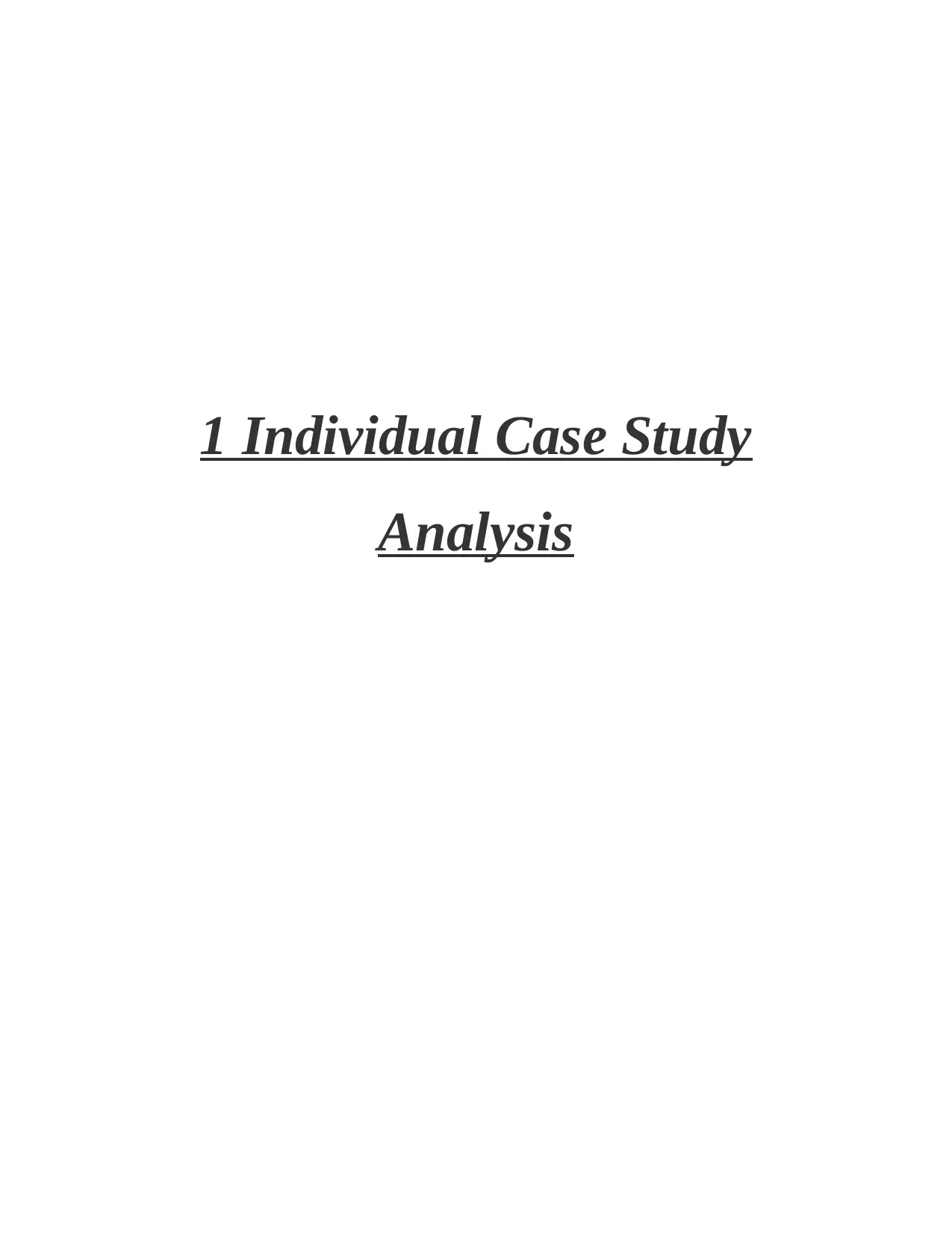
1 Individual Case Study
Analysis
Analysis
Paraphrase This Document
Need a fresh take? Get an instant paraphrase of this document with our AI Paraphraser
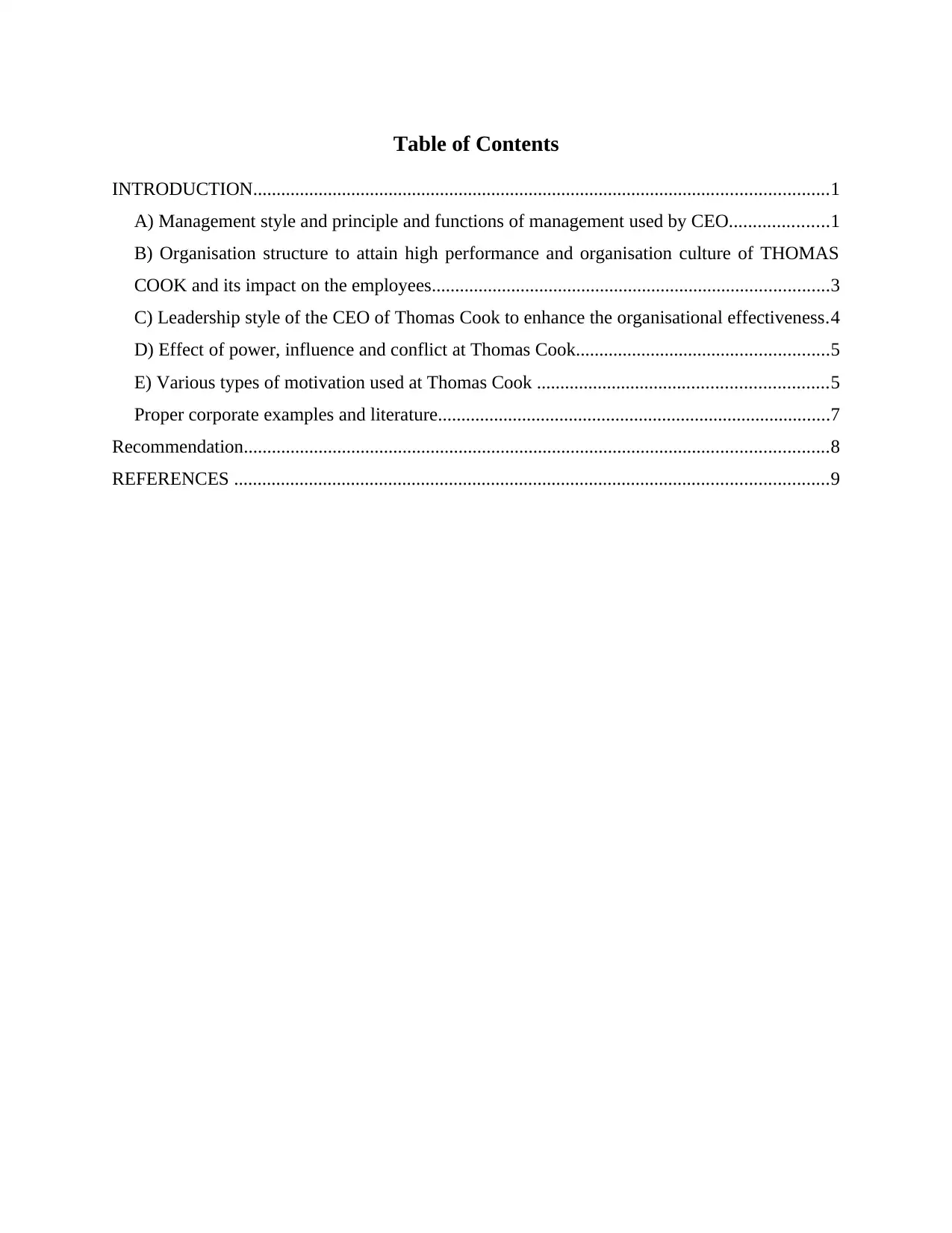
Table of Contents
INTRODUCTION...........................................................................................................................1
A) Management style and principle and functions of management used by CEO.....................1
B) Organisation structure to attain high performance and organisation culture of THOMAS
COOK and its impact on the employees.....................................................................................3
C) Leadership style of the CEO of Thomas Cook to enhance the organisational effectiveness.4
D) Effect of power, influence and conflict at Thomas Cook......................................................5
E) Various types of motivation used at Thomas Cook ..............................................................5
Proper corporate examples and literature....................................................................................7
Recommendation.............................................................................................................................8
REFERENCES ...............................................................................................................................9
INTRODUCTION...........................................................................................................................1
A) Management style and principle and functions of management used by CEO.....................1
B) Organisation structure to attain high performance and organisation culture of THOMAS
COOK and its impact on the employees.....................................................................................3
C) Leadership style of the CEO of Thomas Cook to enhance the organisational effectiveness.4
D) Effect of power, influence and conflict at Thomas Cook......................................................5
E) Various types of motivation used at Thomas Cook ..............................................................5
Proper corporate examples and literature....................................................................................7
Recommendation.............................................................................................................................8
REFERENCES ...............................................................................................................................9

⊘ This is a preview!⊘
Do you want full access?
Subscribe today to unlock all pages.

Trusted by 1+ million students worldwide
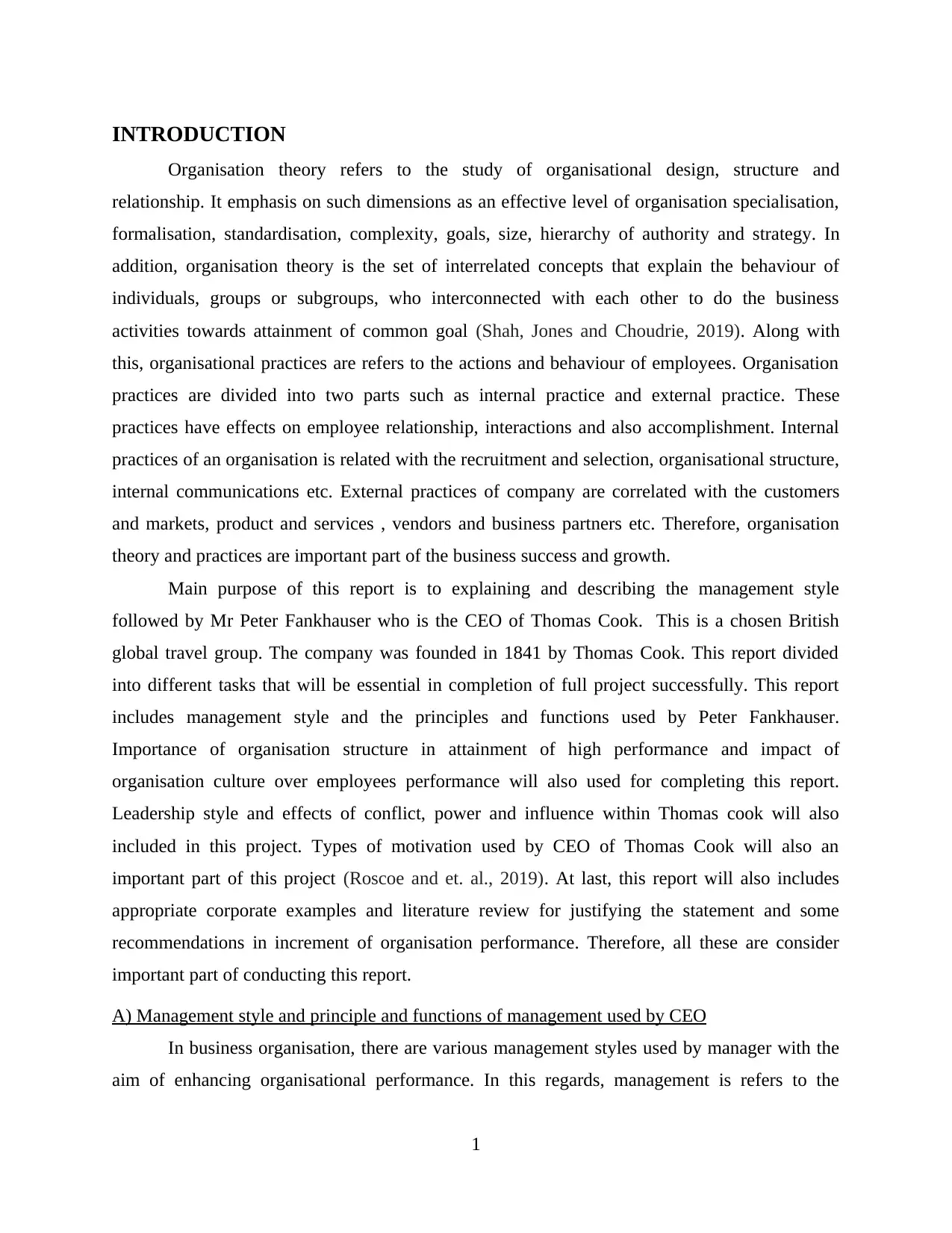
INTRODUCTION
Organisation theory refers to the study of organisational design, structure and
relationship. It emphasis on such dimensions as an effective level of organisation specialisation,
formalisation, standardisation, complexity, goals, size, hierarchy of authority and strategy. In
addition, organisation theory is the set of interrelated concepts that explain the behaviour of
individuals, groups or subgroups, who interconnected with each other to do the business
activities towards attainment of common goal (Shah, Jones and Choudrie, 2019). Along with
this, organisational practices are refers to the actions and behaviour of employees. Organisation
practices are divided into two parts such as internal practice and external practice. These
practices have effects on employee relationship, interactions and also accomplishment. Internal
practices of an organisation is related with the recruitment and selection, organisational structure,
internal communications etc. External practices of company are correlated with the customers
and markets, product and services , vendors and business partners etc. Therefore, organisation
theory and practices are important part of the business success and growth.
Main purpose of this report is to explaining and describing the management style
followed by Mr Peter Fankhauser who is the CEO of Thomas Cook. This is a chosen British
global travel group. The company was founded in 1841 by Thomas Cook. This report divided
into different tasks that will be essential in completion of full project successfully. This report
includes management style and the principles and functions used by Peter Fankhauser.
Importance of organisation structure in attainment of high performance and impact of
organisation culture over employees performance will also used for completing this report.
Leadership style and effects of conflict, power and influence within Thomas cook will also
included in this project. Types of motivation used by CEO of Thomas Cook will also an
important part of this project (Roscoe and et. al., 2019). At last, this report will also includes
appropriate corporate examples and literature review for justifying the statement and some
recommendations in increment of organisation performance. Therefore, all these are consider
important part of conducting this report.
A) Management style and principle and functions of management used by CEO
In business organisation, there are various management styles used by manager with the
aim of enhancing organisational performance. In this regards, management is refers to the
1
Organisation theory refers to the study of organisational design, structure and
relationship. It emphasis on such dimensions as an effective level of organisation specialisation,
formalisation, standardisation, complexity, goals, size, hierarchy of authority and strategy. In
addition, organisation theory is the set of interrelated concepts that explain the behaviour of
individuals, groups or subgroups, who interconnected with each other to do the business
activities towards attainment of common goal (Shah, Jones and Choudrie, 2019). Along with
this, organisational practices are refers to the actions and behaviour of employees. Organisation
practices are divided into two parts such as internal practice and external practice. These
practices have effects on employee relationship, interactions and also accomplishment. Internal
practices of an organisation is related with the recruitment and selection, organisational structure,
internal communications etc. External practices of company are correlated with the customers
and markets, product and services , vendors and business partners etc. Therefore, organisation
theory and practices are important part of the business success and growth.
Main purpose of this report is to explaining and describing the management style
followed by Mr Peter Fankhauser who is the CEO of Thomas Cook. This is a chosen British
global travel group. The company was founded in 1841 by Thomas Cook. This report divided
into different tasks that will be essential in completion of full project successfully. This report
includes management style and the principles and functions used by Peter Fankhauser.
Importance of organisation structure in attainment of high performance and impact of
organisation culture over employees performance will also used for completing this report.
Leadership style and effects of conflict, power and influence within Thomas cook will also
included in this project. Types of motivation used by CEO of Thomas Cook will also an
important part of this project (Roscoe and et. al., 2019). At last, this report will also includes
appropriate corporate examples and literature review for justifying the statement and some
recommendations in increment of organisation performance. Therefore, all these are consider
important part of conducting this report.
A) Management style and principle and functions of management used by CEO
In business organisation, there are various management styles used by manager with the
aim of enhancing organisational performance. In this regards, management is refers to the
1
Paraphrase This Document
Need a fresh take? Get an instant paraphrase of this document with our AI Paraphraser
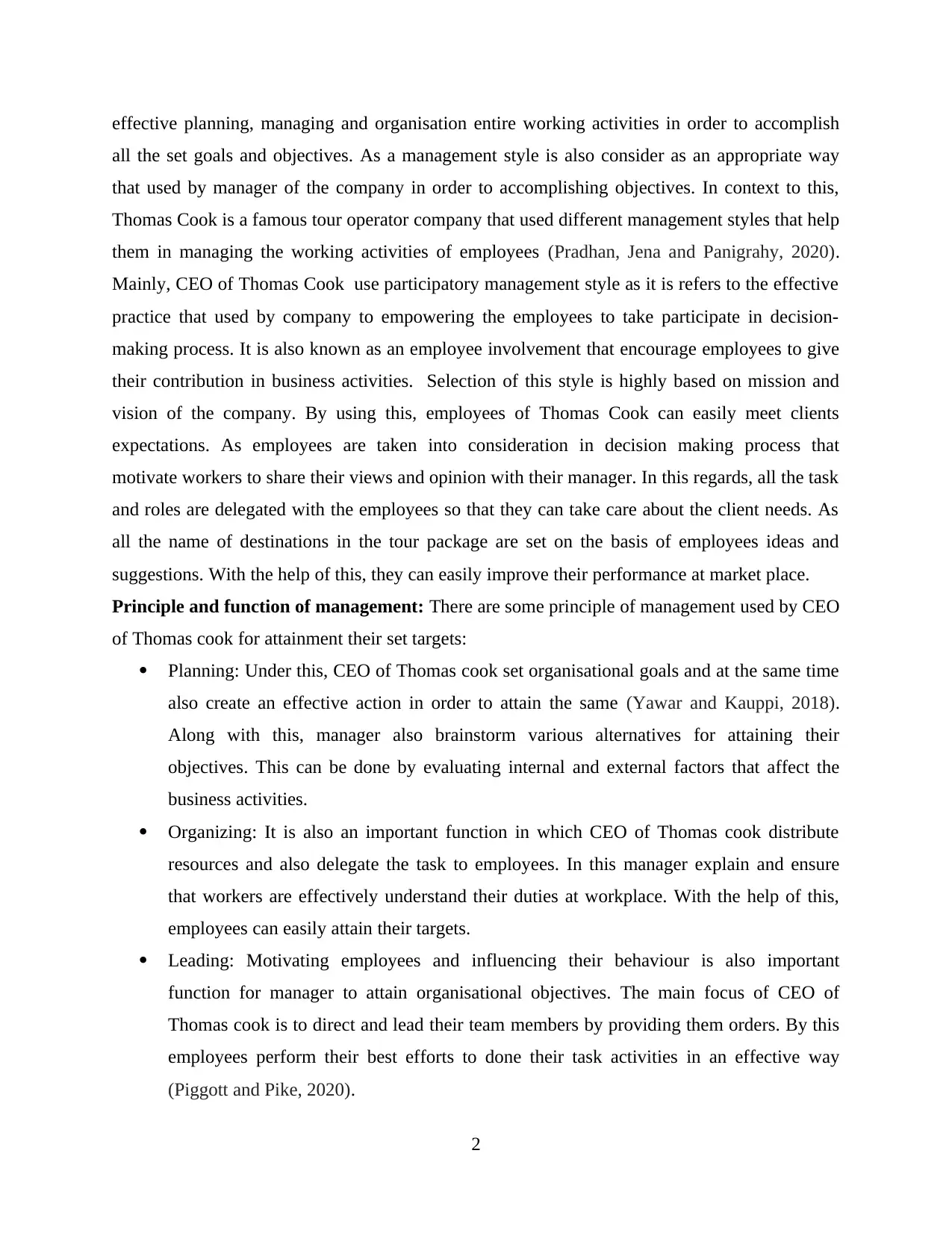
effective planning, managing and organisation entire working activities in order to accomplish
all the set goals and objectives. As a management style is also consider as an appropriate way
that used by manager of the company in order to accomplishing objectives. In context to this,
Thomas Cook is a famous tour operator company that used different management styles that help
them in managing the working activities of employees (Pradhan, Jena and Panigrahy, 2020).
Mainly, CEO of Thomas Cook use participatory management style as it is refers to the effective
practice that used by company to empowering the employees to take participate in decision-
making process. It is also known as an employee involvement that encourage employees to give
their contribution in business activities. Selection of this style is highly based on mission and
vision of the company. By using this, employees of Thomas Cook can easily meet clients
expectations. As employees are taken into consideration in decision making process that
motivate workers to share their views and opinion with their manager. In this regards, all the task
and roles are delegated with the employees so that they can take care about the client needs. As
all the name of destinations in the tour package are set on the basis of employees ideas and
suggestions. With the help of this, they can easily improve their performance at market place.
Principle and function of management: There are some principle of management used by CEO
of Thomas cook for attainment their set targets:
Planning: Under this, CEO of Thomas cook set organisational goals and at the same time
also create an effective action in order to attain the same (Yawar and Kauppi, 2018).
Along with this, manager also brainstorm various alternatives for attaining their
objectives. This can be done by evaluating internal and external factors that affect the
business activities.
Organizing: It is also an important function in which CEO of Thomas cook distribute
resources and also delegate the task to employees. In this manager explain and ensure
that workers are effectively understand their duties at workplace. With the help of this,
employees can easily attain their targets.
Leading: Motivating employees and influencing their behaviour is also important
function for manager to attain organisational objectives. The main focus of CEO of
Thomas cook is to direct and lead their team members by providing them orders. By this
employees perform their best efforts to done their task activities in an effective way
(Piggott and Pike, 2020).
2
all the set goals and objectives. As a management style is also consider as an appropriate way
that used by manager of the company in order to accomplishing objectives. In context to this,
Thomas Cook is a famous tour operator company that used different management styles that help
them in managing the working activities of employees (Pradhan, Jena and Panigrahy, 2020).
Mainly, CEO of Thomas Cook use participatory management style as it is refers to the effective
practice that used by company to empowering the employees to take participate in decision-
making process. It is also known as an employee involvement that encourage employees to give
their contribution in business activities. Selection of this style is highly based on mission and
vision of the company. By using this, employees of Thomas Cook can easily meet clients
expectations. As employees are taken into consideration in decision making process that
motivate workers to share their views and opinion with their manager. In this regards, all the task
and roles are delegated with the employees so that they can take care about the client needs. As
all the name of destinations in the tour package are set on the basis of employees ideas and
suggestions. With the help of this, they can easily improve their performance at market place.
Principle and function of management: There are some principle of management used by CEO
of Thomas cook for attainment their set targets:
Planning: Under this, CEO of Thomas cook set organisational goals and at the same time
also create an effective action in order to attain the same (Yawar and Kauppi, 2018).
Along with this, manager also brainstorm various alternatives for attaining their
objectives. This can be done by evaluating internal and external factors that affect the
business activities.
Organizing: It is also an important function in which CEO of Thomas cook distribute
resources and also delegate the task to employees. In this manager explain and ensure
that workers are effectively understand their duties at workplace. With the help of this,
employees can easily attain their targets.
Leading: Motivating employees and influencing their behaviour is also important
function for manager to attain organisational objectives. The main focus of CEO of
Thomas cook is to direct and lead their team members by providing them orders. By this
employees perform their best efforts to done their task activities in an effective way
(Piggott and Pike, 2020).
2
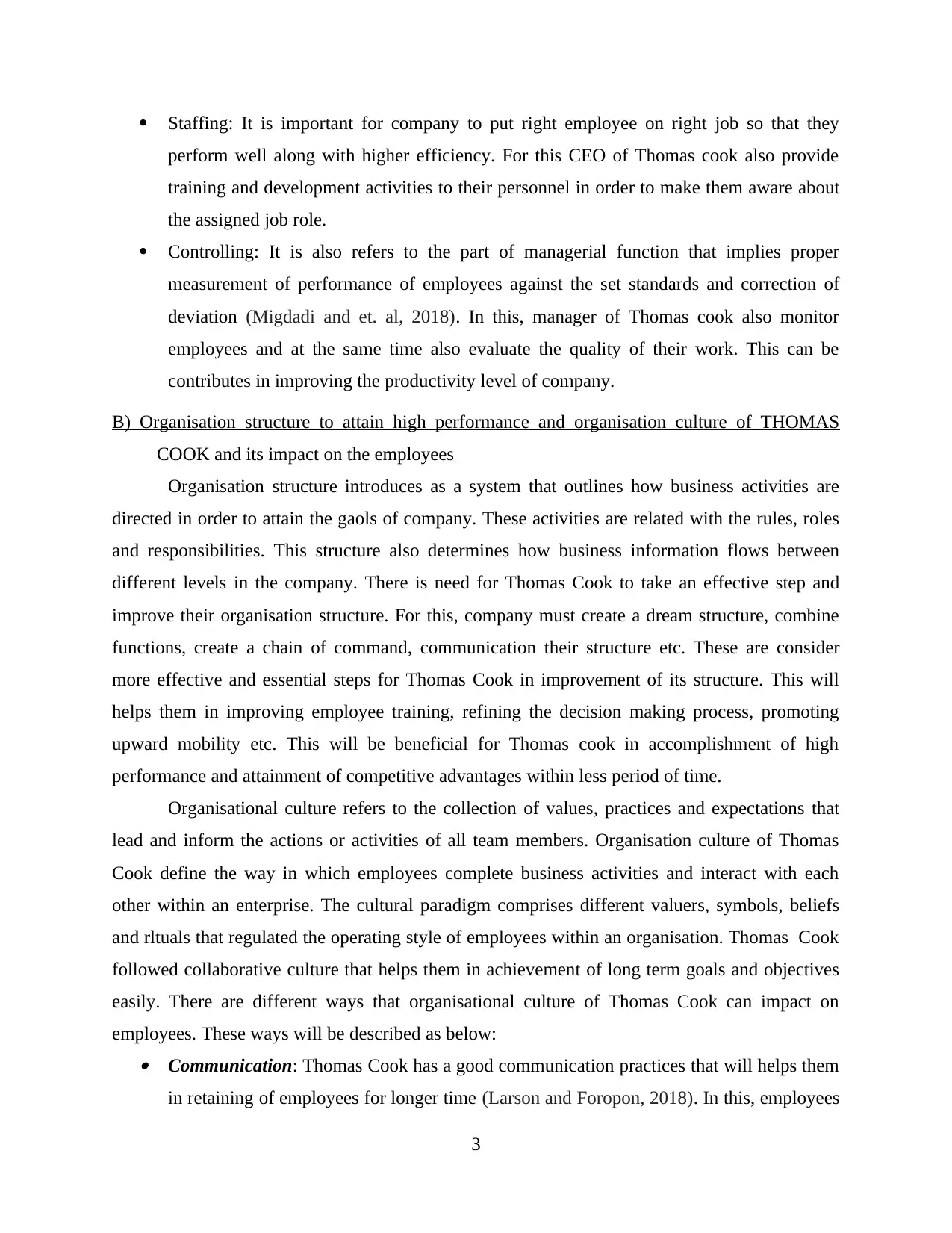
Staffing: It is important for company to put right employee on right job so that they
perform well along with higher efficiency. For this CEO of Thomas cook also provide
training and development activities to their personnel in order to make them aware about
the assigned job role.
Controlling: It is also refers to the part of managerial function that implies proper
measurement of performance of employees against the set standards and correction of
deviation (Migdadi and et. al, 2018). In this, manager of Thomas cook also monitor
employees and at the same time also evaluate the quality of their work. This can be
contributes in improving the productivity level of company.
B) Organisation structure to attain high performance and organisation culture of THOMAS
COOK and its impact on the employees
Organisation structure introduces as a system that outlines how business activities are
directed in order to attain the gaols of company. These activities are related with the rules, roles
and responsibilities. This structure also determines how business information flows between
different levels in the company. There is need for Thomas Cook to take an effective step and
improve their organisation structure. For this, company must create a dream structure, combine
functions, create a chain of command, communication their structure etc. These are consider
more effective and essential steps for Thomas Cook in improvement of its structure. This will
helps them in improving employee training, refining the decision making process, promoting
upward mobility etc. This will be beneficial for Thomas cook in accomplishment of high
performance and attainment of competitive advantages within less period of time.
Organisational culture refers to the collection of values, practices and expectations that
lead and inform the actions or activities of all team members. Organisation culture of Thomas
Cook define the way in which employees complete business activities and interact with each
other within an enterprise. The cultural paradigm comprises different valuers, symbols, beliefs
and rltuals that regulated the operating style of employees within an organisation. Thomas Cook
followed collaborative culture that helps them in achievement of long term goals and objectives
easily. There are different ways that organisational culture of Thomas Cook can impact on
employees. These ways will be described as below: Communication: Thomas Cook has a good communication practices that will helps them
in retaining of employees for longer time (Larson and Foropon, 2018). In this, employees
3
perform well along with higher efficiency. For this CEO of Thomas cook also provide
training and development activities to their personnel in order to make them aware about
the assigned job role.
Controlling: It is also refers to the part of managerial function that implies proper
measurement of performance of employees against the set standards and correction of
deviation (Migdadi and et. al, 2018). In this, manager of Thomas cook also monitor
employees and at the same time also evaluate the quality of their work. This can be
contributes in improving the productivity level of company.
B) Organisation structure to attain high performance and organisation culture of THOMAS
COOK and its impact on the employees
Organisation structure introduces as a system that outlines how business activities are
directed in order to attain the gaols of company. These activities are related with the rules, roles
and responsibilities. This structure also determines how business information flows between
different levels in the company. There is need for Thomas Cook to take an effective step and
improve their organisation structure. For this, company must create a dream structure, combine
functions, create a chain of command, communication their structure etc. These are consider
more effective and essential steps for Thomas Cook in improvement of its structure. This will
helps them in improving employee training, refining the decision making process, promoting
upward mobility etc. This will be beneficial for Thomas cook in accomplishment of high
performance and attainment of competitive advantages within less period of time.
Organisational culture refers to the collection of values, practices and expectations that
lead and inform the actions or activities of all team members. Organisation culture of Thomas
Cook define the way in which employees complete business activities and interact with each
other within an enterprise. The cultural paradigm comprises different valuers, symbols, beliefs
and rltuals that regulated the operating style of employees within an organisation. Thomas Cook
followed collaborative culture that helps them in achievement of long term goals and objectives
easily. There are different ways that organisational culture of Thomas Cook can impact on
employees. These ways will be described as below: Communication: Thomas Cook has a good communication practices that will helps them
in retaining of employees for longer time (Larson and Foropon, 2018). In this, employees
3
⊘ This is a preview!⊘
Do you want full access?
Subscribe today to unlock all pages.

Trusted by 1+ million students worldwide
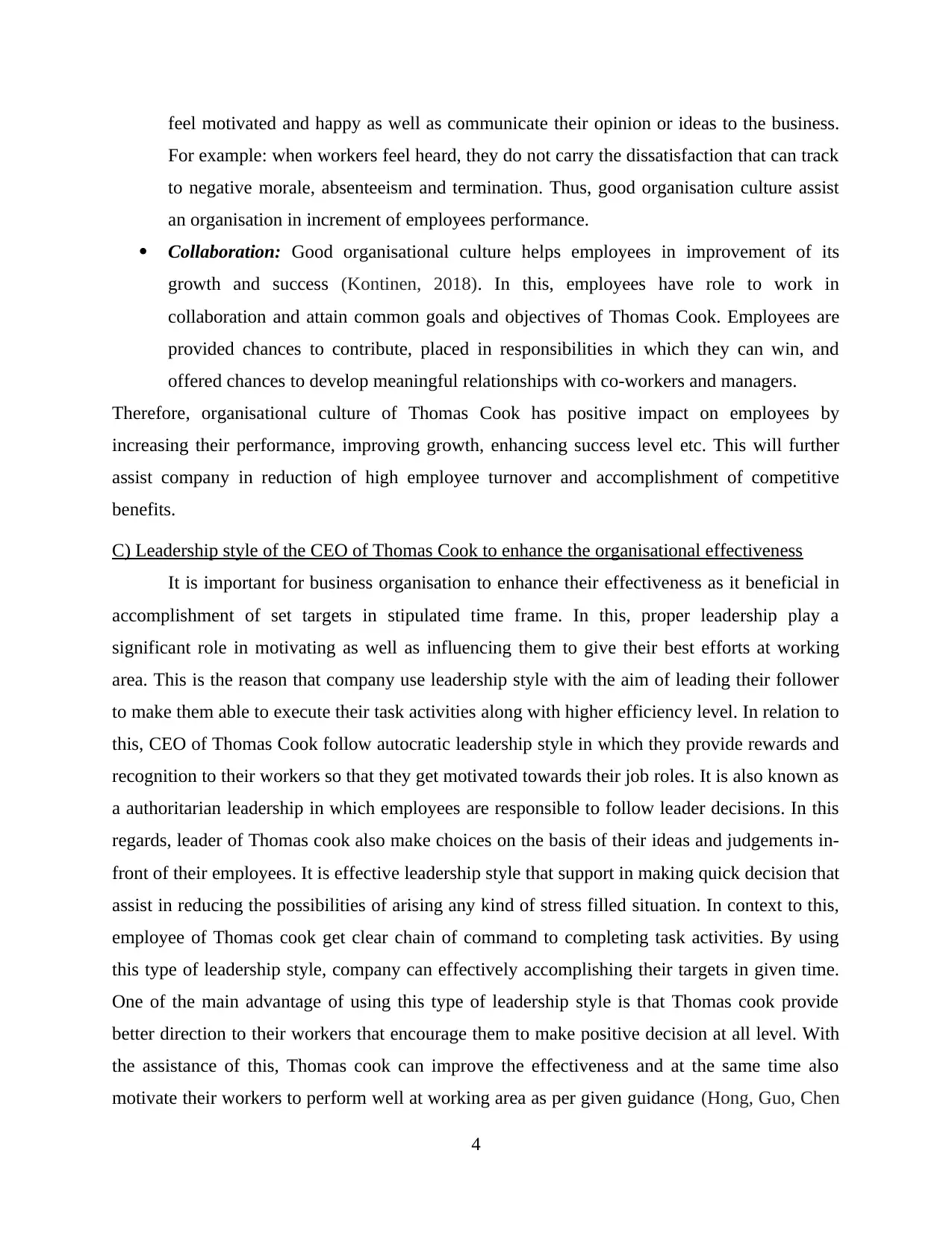
feel motivated and happy as well as communicate their opinion or ideas to the business.
For example: when workers feel heard, they do not carry the dissatisfaction that can track
to negative morale, absenteeism and termination. Thus, good organisation culture assist
an organisation in increment of employees performance.
Collaboration: Good organisational culture helps employees in improvement of its
growth and success (Kontinen, 2018). In this, employees have role to work in
collaboration and attain common goals and objectives of Thomas Cook. Employees are
provided chances to contribute, placed in responsibilities in which they can win, and
offered chances to develop meaningful relationships with co-workers and managers.
Therefore, organisational culture of Thomas Cook has positive impact on employees by
increasing their performance, improving growth, enhancing success level etc. This will further
assist company in reduction of high employee turnover and accomplishment of competitive
benefits.
C) Leadership style of the CEO of Thomas Cook to enhance the organisational effectiveness
It is important for business organisation to enhance their effectiveness as it beneficial in
accomplishment of set targets in stipulated time frame. In this, proper leadership play a
significant role in motivating as well as influencing them to give their best efforts at working
area. This is the reason that company use leadership style with the aim of leading their follower
to make them able to execute their task activities along with higher efficiency level. In relation to
this, CEO of Thomas Cook follow autocratic leadership style in which they provide rewards and
recognition to their workers so that they get motivated towards their job roles. It is also known as
a authoritarian leadership in which employees are responsible to follow leader decisions. In this
regards, leader of Thomas cook also make choices on the basis of their ideas and judgements in-
front of their employees. It is effective leadership style that support in making quick decision that
assist in reducing the possibilities of arising any kind of stress filled situation. In context to this,
employee of Thomas cook get clear chain of command to completing task activities. By using
this type of leadership style, company can effectively accomplishing their targets in given time.
One of the main advantage of using this type of leadership style is that Thomas cook provide
better direction to their workers that encourage them to make positive decision at all level. With
the assistance of this, Thomas cook can improve the effectiveness and at the same time also
motivate their workers to perform well at working area as per given guidance (Hong, Guo, Chen
4
For example: when workers feel heard, they do not carry the dissatisfaction that can track
to negative morale, absenteeism and termination. Thus, good organisation culture assist
an organisation in increment of employees performance.
Collaboration: Good organisational culture helps employees in improvement of its
growth and success (Kontinen, 2018). In this, employees have role to work in
collaboration and attain common goals and objectives of Thomas Cook. Employees are
provided chances to contribute, placed in responsibilities in which they can win, and
offered chances to develop meaningful relationships with co-workers and managers.
Therefore, organisational culture of Thomas Cook has positive impact on employees by
increasing their performance, improving growth, enhancing success level etc. This will further
assist company in reduction of high employee turnover and accomplishment of competitive
benefits.
C) Leadership style of the CEO of Thomas Cook to enhance the organisational effectiveness
It is important for business organisation to enhance their effectiveness as it beneficial in
accomplishment of set targets in stipulated time frame. In this, proper leadership play a
significant role in motivating as well as influencing them to give their best efforts at working
area. This is the reason that company use leadership style with the aim of leading their follower
to make them able to execute their task activities along with higher efficiency level. In relation to
this, CEO of Thomas Cook follow autocratic leadership style in which they provide rewards and
recognition to their workers so that they get motivated towards their job roles. It is also known as
a authoritarian leadership in which employees are responsible to follow leader decisions. In this
regards, leader of Thomas cook also make choices on the basis of their ideas and judgements in-
front of their employees. It is effective leadership style that support in making quick decision that
assist in reducing the possibilities of arising any kind of stress filled situation. In context to this,
employee of Thomas cook get clear chain of command to completing task activities. By using
this type of leadership style, company can effectively accomplishing their targets in given time.
One of the main advantage of using this type of leadership style is that Thomas cook provide
better direction to their workers that encourage them to make positive decision at all level. With
the assistance of this, Thomas cook can improve the effectiveness and at the same time also
motivate their workers to perform well at working area as per given guidance (Hong, Guo, Chen
4
Paraphrase This Document
Need a fresh take? Get an instant paraphrase of this document with our AI Paraphraser
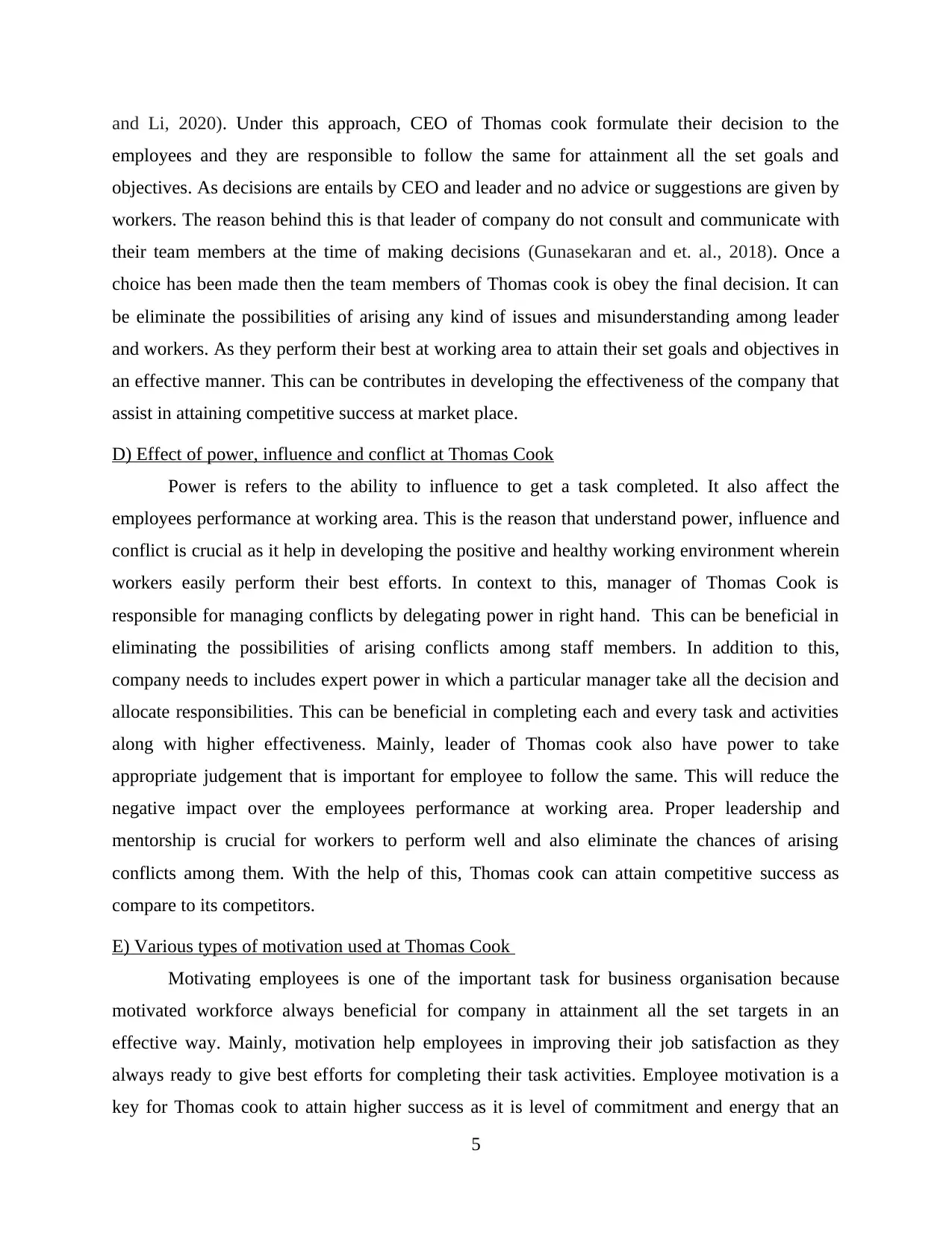
and Li, 2020). Under this approach, CEO of Thomas cook formulate their decision to the
employees and they are responsible to follow the same for attainment all the set goals and
objectives. As decisions are entails by CEO and leader and no advice or suggestions are given by
workers. The reason behind this is that leader of company do not consult and communicate with
their team members at the time of making decisions (Gunasekaran and et. al., 2018). Once a
choice has been made then the team members of Thomas cook is obey the final decision. It can
be eliminate the possibilities of arising any kind of issues and misunderstanding among leader
and workers. As they perform their best at working area to attain their set goals and objectives in
an effective manner. This can be contributes in developing the effectiveness of the company that
assist in attaining competitive success at market place.
D) Effect of power, influence and conflict at Thomas Cook
Power is refers to the ability to influence to get a task completed. It also affect the
employees performance at working area. This is the reason that understand power, influence and
conflict is crucial as it help in developing the positive and healthy working environment wherein
workers easily perform their best efforts. In context to this, manager of Thomas Cook is
responsible for managing conflicts by delegating power in right hand. This can be beneficial in
eliminating the possibilities of arising conflicts among staff members. In addition to this,
company needs to includes expert power in which a particular manager take all the decision and
allocate responsibilities. This can be beneficial in completing each and every task and activities
along with higher effectiveness. Mainly, leader of Thomas cook also have power to take
appropriate judgement that is important for employee to follow the same. This will reduce the
negative impact over the employees performance at working area. Proper leadership and
mentorship is crucial for workers to perform well and also eliminate the chances of arising
conflicts among them. With the help of this, Thomas cook can attain competitive success as
compare to its competitors.
E) Various types of motivation used at Thomas Cook
Motivating employees is one of the important task for business organisation because
motivated workforce always beneficial for company in attainment all the set targets in an
effective way. Mainly, motivation help employees in improving their job satisfaction as they
always ready to give best efforts for completing their task activities. Employee motivation is a
key for Thomas cook to attain higher success as it is level of commitment and energy that an
5
employees and they are responsible to follow the same for attainment all the set goals and
objectives. As decisions are entails by CEO and leader and no advice or suggestions are given by
workers. The reason behind this is that leader of company do not consult and communicate with
their team members at the time of making decisions (Gunasekaran and et. al., 2018). Once a
choice has been made then the team members of Thomas cook is obey the final decision. It can
be eliminate the possibilities of arising any kind of issues and misunderstanding among leader
and workers. As they perform their best at working area to attain their set goals and objectives in
an effective manner. This can be contributes in developing the effectiveness of the company that
assist in attaining competitive success at market place.
D) Effect of power, influence and conflict at Thomas Cook
Power is refers to the ability to influence to get a task completed. It also affect the
employees performance at working area. This is the reason that understand power, influence and
conflict is crucial as it help in developing the positive and healthy working environment wherein
workers easily perform their best efforts. In context to this, manager of Thomas Cook is
responsible for managing conflicts by delegating power in right hand. This can be beneficial in
eliminating the possibilities of arising conflicts among staff members. In addition to this,
company needs to includes expert power in which a particular manager take all the decision and
allocate responsibilities. This can be beneficial in completing each and every task and activities
along with higher effectiveness. Mainly, leader of Thomas cook also have power to take
appropriate judgement that is important for employee to follow the same. This will reduce the
negative impact over the employees performance at working area. Proper leadership and
mentorship is crucial for workers to perform well and also eliminate the chances of arising
conflicts among them. With the help of this, Thomas cook can attain competitive success as
compare to its competitors.
E) Various types of motivation used at Thomas Cook
Motivating employees is one of the important task for business organisation because
motivated workforce always beneficial for company in attainment all the set targets in an
effective way. Mainly, motivation help employees in improving their job satisfaction as they
always ready to give best efforts for completing their task activities. Employee motivation is a
key for Thomas cook to attain higher success as it is level of commitment and energy that an
5
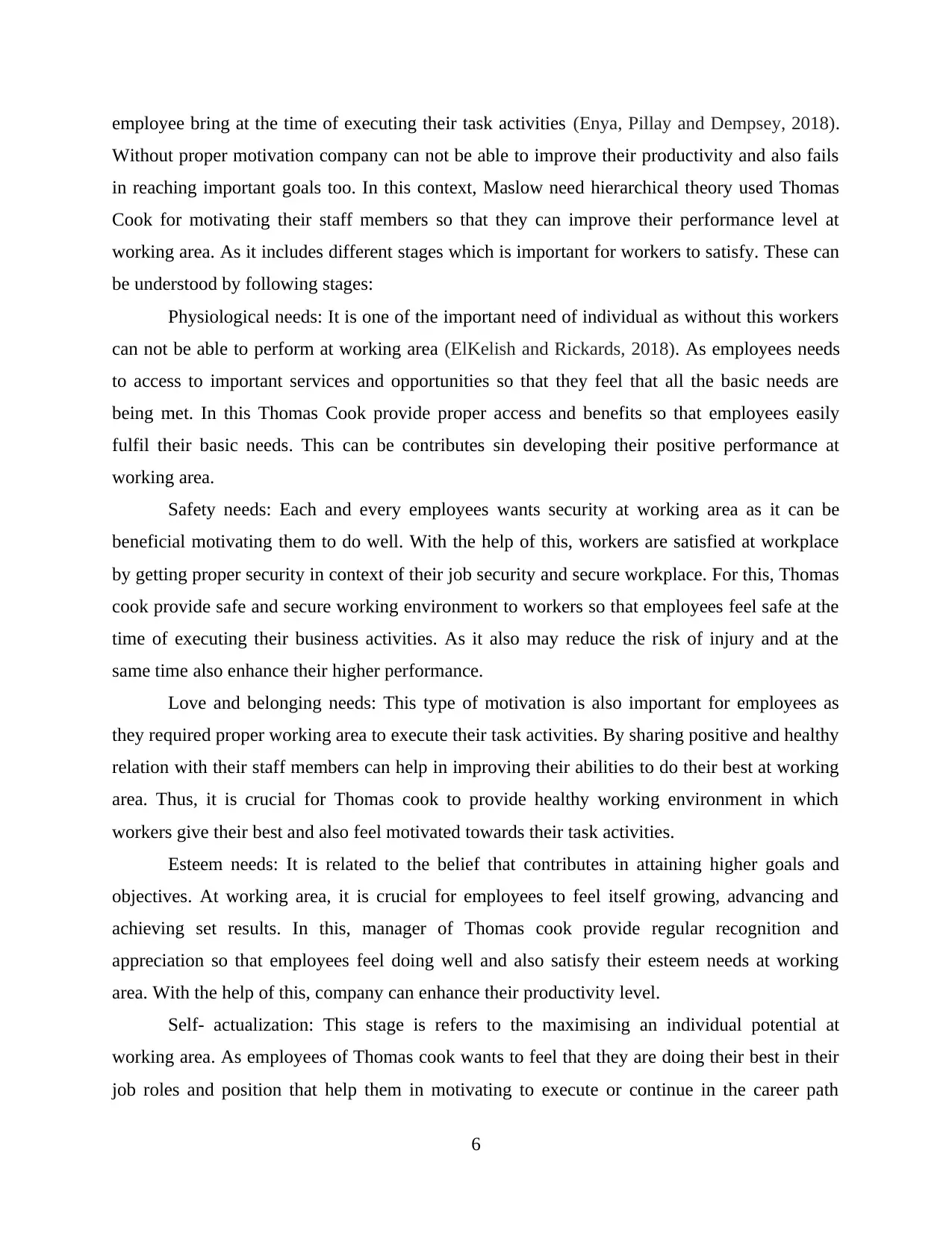
employee bring at the time of executing their task activities (Enya, Pillay and Dempsey, 2018).
Without proper motivation company can not be able to improve their productivity and also fails
in reaching important goals too. In this context, Maslow need hierarchical theory used Thomas
Cook for motivating their staff members so that they can improve their performance level at
working area. As it includes different stages which is important for workers to satisfy. These can
be understood by following stages:
Physiological needs: It is one of the important need of individual as without this workers
can not be able to perform at working area (ElKelish and Rickards, 2018). As employees needs
to access to important services and opportunities so that they feel that all the basic needs are
being met. In this Thomas Cook provide proper access and benefits so that employees easily
fulfil their basic needs. This can be contributes sin developing their positive performance at
working area.
Safety needs: Each and every employees wants security at working area as it can be
beneficial motivating them to do well. With the help of this, workers are satisfied at workplace
by getting proper security in context of their job security and secure workplace. For this, Thomas
cook provide safe and secure working environment to workers so that employees feel safe at the
time of executing their business activities. As it also may reduce the risk of injury and at the
same time also enhance their higher performance.
Love and belonging needs: This type of motivation is also important for employees as
they required proper working area to execute their task activities. By sharing positive and healthy
relation with their staff members can help in improving their abilities to do their best at working
area. Thus, it is crucial for Thomas cook to provide healthy working environment in which
workers give their best and also feel motivated towards their task activities.
Esteem needs: It is related to the belief that contributes in attaining higher goals and
objectives. At working area, it is crucial for employees to feel itself growing, advancing and
achieving set results. In this, manager of Thomas cook provide regular recognition and
appreciation so that employees feel doing well and also satisfy their esteem needs at working
area. With the help of this, company can enhance their productivity level.
Self- actualization: This stage is refers to the maximising an individual potential at
working area. As employees of Thomas cook wants to feel that they are doing their best in their
job roles and position that help them in motivating to execute or continue in the career path
6
Without proper motivation company can not be able to improve their productivity and also fails
in reaching important goals too. In this context, Maslow need hierarchical theory used Thomas
Cook for motivating their staff members so that they can improve their performance level at
working area. As it includes different stages which is important for workers to satisfy. These can
be understood by following stages:
Physiological needs: It is one of the important need of individual as without this workers
can not be able to perform at working area (ElKelish and Rickards, 2018). As employees needs
to access to important services and opportunities so that they feel that all the basic needs are
being met. In this Thomas Cook provide proper access and benefits so that employees easily
fulfil their basic needs. This can be contributes sin developing their positive performance at
working area.
Safety needs: Each and every employees wants security at working area as it can be
beneficial motivating them to do well. With the help of this, workers are satisfied at workplace
by getting proper security in context of their job security and secure workplace. For this, Thomas
cook provide safe and secure working environment to workers so that employees feel safe at the
time of executing their business activities. As it also may reduce the risk of injury and at the
same time also enhance their higher performance.
Love and belonging needs: This type of motivation is also important for employees as
they required proper working area to execute their task activities. By sharing positive and healthy
relation with their staff members can help in improving their abilities to do their best at working
area. Thus, it is crucial for Thomas cook to provide healthy working environment in which
workers give their best and also feel motivated towards their task activities.
Esteem needs: It is related to the belief that contributes in attaining higher goals and
objectives. At working area, it is crucial for employees to feel itself growing, advancing and
achieving set results. In this, manager of Thomas cook provide regular recognition and
appreciation so that employees feel doing well and also satisfy their esteem needs at working
area. With the help of this, company can enhance their productivity level.
Self- actualization: This stage is refers to the maximising an individual potential at
working area. As employees of Thomas cook wants to feel that they are doing their best in their
job roles and position that help them in motivating to execute or continue in the career path
6
⊘ This is a preview!⊘
Do you want full access?
Subscribe today to unlock all pages.

Trusted by 1+ million students worldwide
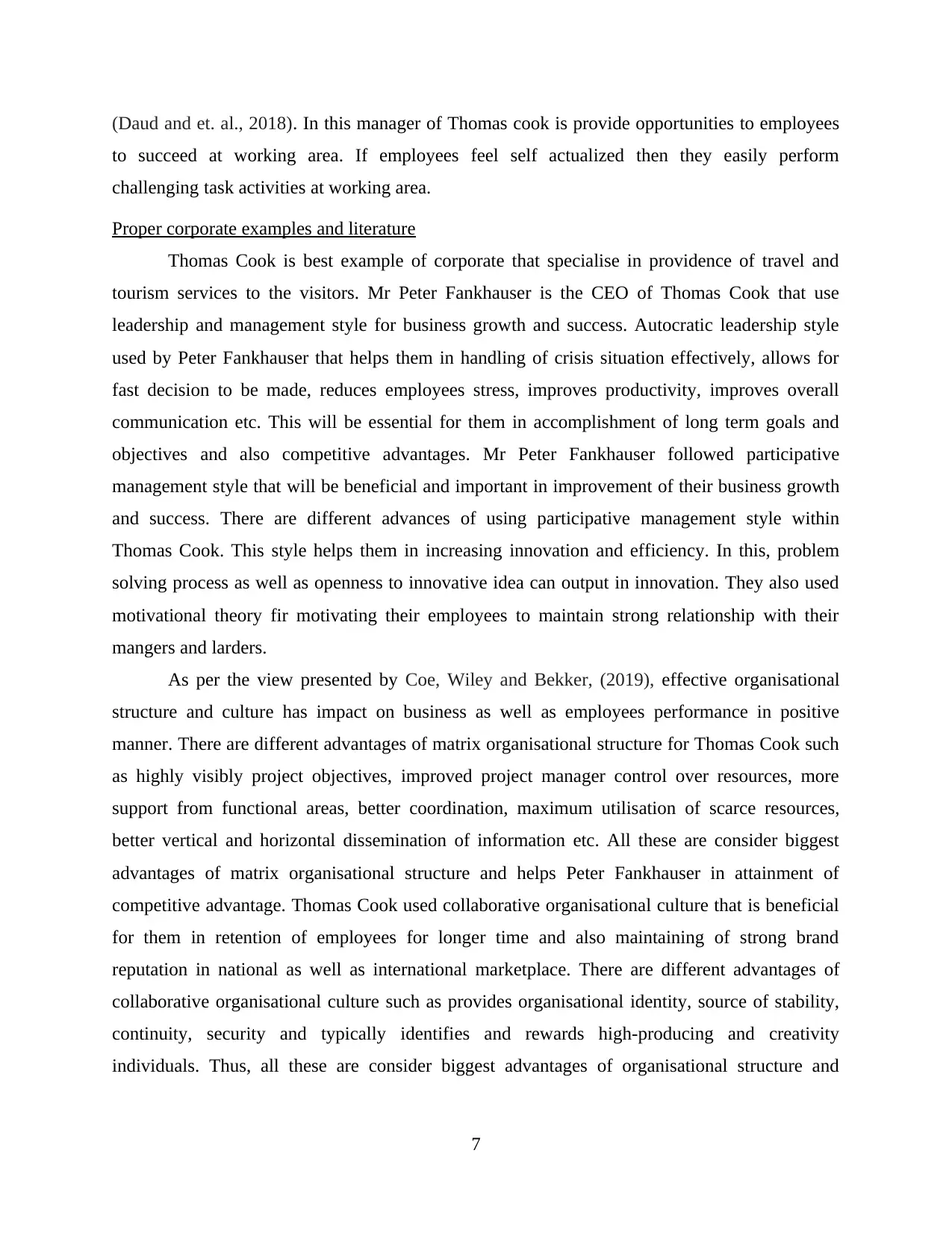
(Daud and et. al., 2018). In this manager of Thomas cook is provide opportunities to employees
to succeed at working area. If employees feel self actualized then they easily perform
challenging task activities at working area.
Proper corporate examples and literature
Thomas Cook is best example of corporate that specialise in providence of travel and
tourism services to the visitors. Mr Peter Fankhauser is the CEO of Thomas Cook that use
leadership and management style for business growth and success. Autocratic leadership style
used by Peter Fankhauser that helps them in handling of crisis situation effectively, allows for
fast decision to be made, reduces employees stress, improves productivity, improves overall
communication etc. This will be essential for them in accomplishment of long term goals and
objectives and also competitive advantages. Mr Peter Fankhauser followed participative
management style that will be beneficial and important in improvement of their business growth
and success. There are different advances of using participative management style within
Thomas Cook. This style helps them in increasing innovation and efficiency. In this, problem
solving process as well as openness to innovative idea can output in innovation. They also used
motivational theory fir motivating their employees to maintain strong relationship with their
mangers and larders.
As per the view presented by Coe, Wiley and Bekker, (2019), effective organisational
structure and culture has impact on business as well as employees performance in positive
manner. There are different advantages of matrix organisational structure for Thomas Cook such
as highly visibly project objectives, improved project manager control over resources, more
support from functional areas, better coordination, maximum utilisation of scarce resources,
better vertical and horizontal dissemination of information etc. All these are consider biggest
advantages of matrix organisational structure and helps Peter Fankhauser in attainment of
competitive advantage. Thomas Cook used collaborative organisational culture that is beneficial
for them in retention of employees for longer time and also maintaining of strong brand
reputation in national as well as international marketplace. There are different advantages of
collaborative organisational culture such as provides organisational identity, source of stability,
continuity, security and typically identifies and rewards high-producing and creativity
individuals. Thus, all these are consider biggest advantages of organisational structure and
7
to succeed at working area. If employees feel self actualized then they easily perform
challenging task activities at working area.
Proper corporate examples and literature
Thomas Cook is best example of corporate that specialise in providence of travel and
tourism services to the visitors. Mr Peter Fankhauser is the CEO of Thomas Cook that use
leadership and management style for business growth and success. Autocratic leadership style
used by Peter Fankhauser that helps them in handling of crisis situation effectively, allows for
fast decision to be made, reduces employees stress, improves productivity, improves overall
communication etc. This will be essential for them in accomplishment of long term goals and
objectives and also competitive advantages. Mr Peter Fankhauser followed participative
management style that will be beneficial and important in improvement of their business growth
and success. There are different advances of using participative management style within
Thomas Cook. This style helps them in increasing innovation and efficiency. In this, problem
solving process as well as openness to innovative idea can output in innovation. They also used
motivational theory fir motivating their employees to maintain strong relationship with their
mangers and larders.
As per the view presented by Coe, Wiley and Bekker, (2019), effective organisational
structure and culture has impact on business as well as employees performance in positive
manner. There are different advantages of matrix organisational structure for Thomas Cook such
as highly visibly project objectives, improved project manager control over resources, more
support from functional areas, better coordination, maximum utilisation of scarce resources,
better vertical and horizontal dissemination of information etc. All these are consider biggest
advantages of matrix organisational structure and helps Peter Fankhauser in attainment of
competitive advantage. Thomas Cook used collaborative organisational culture that is beneficial
for them in retention of employees for longer time and also maintaining of strong brand
reputation in national as well as international marketplace. There are different advantages of
collaborative organisational culture such as provides organisational identity, source of stability,
continuity, security and typically identifies and rewards high-producing and creativity
individuals. Thus, all these are consider biggest advantages of organisational structure and
7
Paraphrase This Document
Need a fresh take? Get an instant paraphrase of this document with our AI Paraphraser
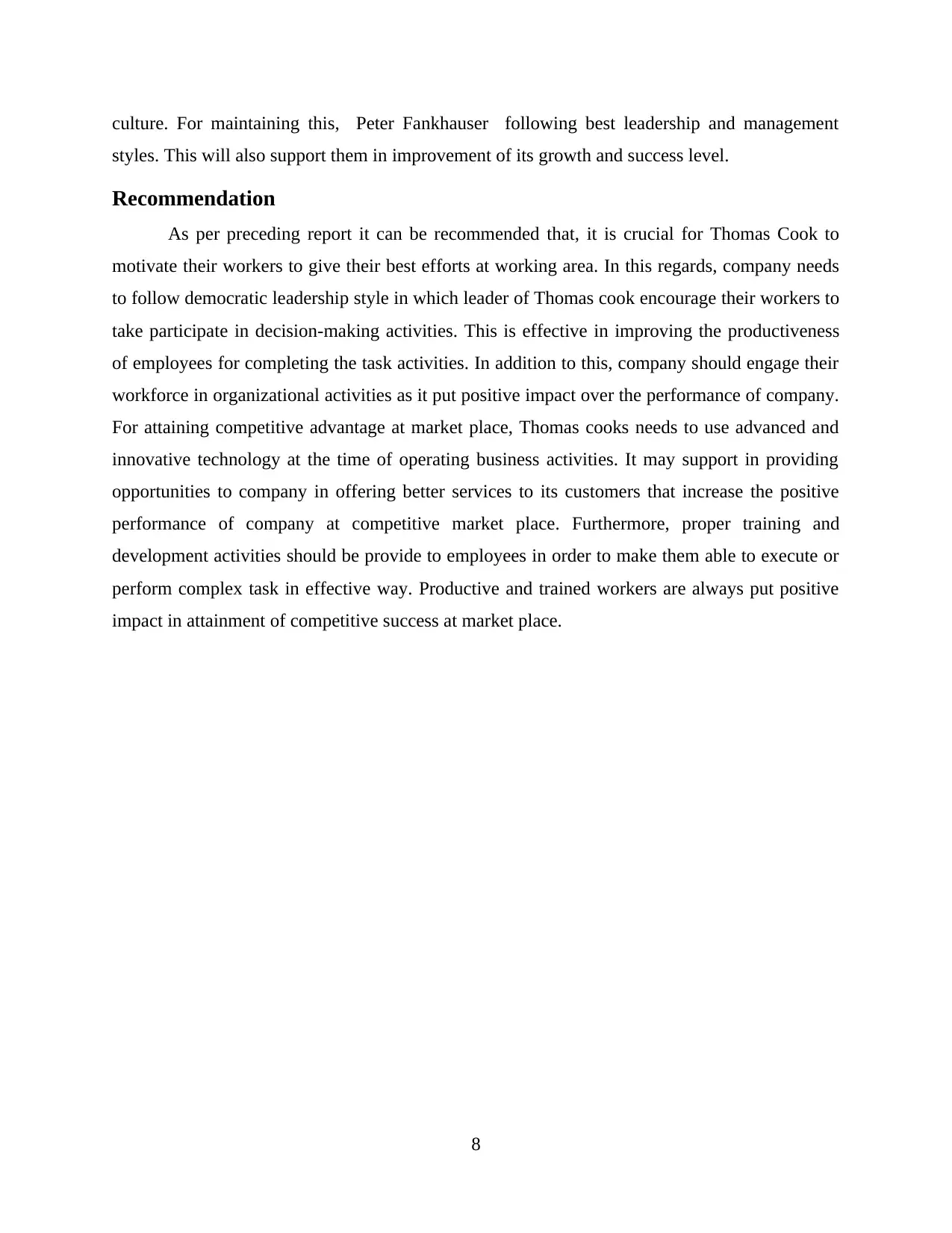
culture. For maintaining this, Peter Fankhauser following best leadership and management
styles. This will also support them in improvement of its growth and success level.
Recommendation
As per preceding report it can be recommended that, it is crucial for Thomas Cook to
motivate their workers to give their best efforts at working area. In this regards, company needs
to follow democratic leadership style in which leader of Thomas cook encourage their workers to
take participate in decision-making activities. This is effective in improving the productiveness
of employees for completing the task activities. In addition to this, company should engage their
workforce in organizational activities as it put positive impact over the performance of company.
For attaining competitive advantage at market place, Thomas cooks needs to use advanced and
innovative technology at the time of operating business activities. It may support in providing
opportunities to company in offering better services to its customers that increase the positive
performance of company at competitive market place. Furthermore, proper training and
development activities should be provide to employees in order to make them able to execute or
perform complex task in effective way. Productive and trained workers are always put positive
impact in attainment of competitive success at market place.
8
styles. This will also support them in improvement of its growth and success level.
Recommendation
As per preceding report it can be recommended that, it is crucial for Thomas Cook to
motivate their workers to give their best efforts at working area. In this regards, company needs
to follow democratic leadership style in which leader of Thomas cook encourage their workers to
take participate in decision-making activities. This is effective in improving the productiveness
of employees for completing the task activities. In addition to this, company should engage their
workforce in organizational activities as it put positive impact over the performance of company.
For attaining competitive advantage at market place, Thomas cooks needs to use advanced and
innovative technology at the time of operating business activities. It may support in providing
opportunities to company in offering better services to its customers that increase the positive
performance of company at competitive market place. Furthermore, proper training and
development activities should be provide to employees in order to make them able to execute or
perform complex task in effective way. Productive and trained workers are always put positive
impact in attainment of competitive success at market place.
8
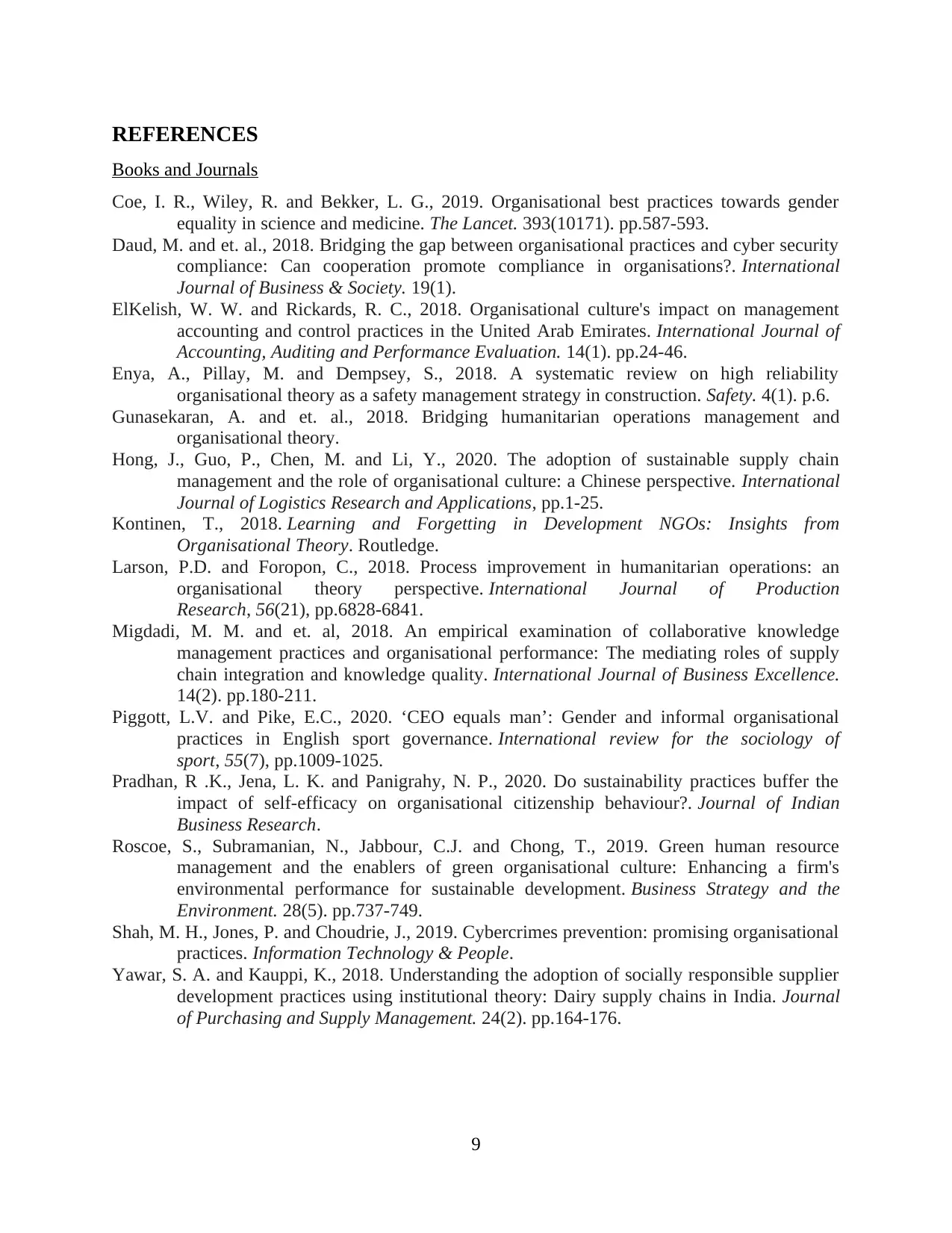
REFERENCES
Books and Journals
Coe, I. R., Wiley, R. and Bekker, L. G., 2019. Organisational best practices towards gender
equality in science and medicine. The Lancet. 393(10171). pp.587-593.
Daud, M. and et. al., 2018. Bridging the gap between organisational practices and cyber security
compliance: Can cooperation promote compliance in organisations?. International
Journal of Business & Society. 19(1).
ElKelish, W. W. and Rickards, R. C., 2018. Organisational culture's impact on management
accounting and control practices in the United Arab Emirates. International Journal of
Accounting, Auditing and Performance Evaluation. 14(1). pp.24-46.
Enya, A., Pillay, M. and Dempsey, S., 2018. A systematic review on high reliability
organisational theory as a safety management strategy in construction. Safety. 4(1). p.6.
Gunasekaran, A. and et. al., 2018. Bridging humanitarian operations management and
organisational theory.
Hong, J., Guo, P., Chen, M. and Li, Y., 2020. The adoption of sustainable supply chain
management and the role of organisational culture: a Chinese perspective. International
Journal of Logistics Research and Applications, pp.1-25.
Kontinen, T., 2018. Learning and Forgetting in Development NGOs: Insights from
Organisational Theory. Routledge.
Larson, P.D. and Foropon, C., 2018. Process improvement in humanitarian operations: an
organisational theory perspective. International Journal of Production
Research, 56(21), pp.6828-6841.
Migdadi, M. M. and et. al, 2018. An empirical examination of collaborative knowledge
management practices and organisational performance: The mediating roles of supply
chain integration and knowledge quality. International Journal of Business Excellence.
14(2). pp.180-211.
Piggott, L.V. and Pike, E.C., 2020. ‘CEO equals man’: Gender and informal organisational
practices in English sport governance. International review for the sociology of
sport, 55(7), pp.1009-1025.
Pradhan, R .K., Jena, L. K. and Panigrahy, N. P., 2020. Do sustainability practices buffer the
impact of self-efficacy on organisational citizenship behaviour?. Journal of Indian
Business Research.
Roscoe, S., Subramanian, N., Jabbour, C.J. and Chong, T., 2019. Green human resource
management and the enablers of green organisational culture: Enhancing a firm's
environmental performance for sustainable development. Business Strategy and the
Environment. 28(5). pp.737-749.
Shah, M. H., Jones, P. and Choudrie, J., 2019. Cybercrimes prevention: promising organisational
practices. Information Technology & People.
Yawar, S. A. and Kauppi, K., 2018. Understanding the adoption of socially responsible supplier
development practices using institutional theory: Dairy supply chains in India. Journal
of Purchasing and Supply Management. 24(2). pp.164-176.
9
Books and Journals
Coe, I. R., Wiley, R. and Bekker, L. G., 2019. Organisational best practices towards gender
equality in science and medicine. The Lancet. 393(10171). pp.587-593.
Daud, M. and et. al., 2018. Bridging the gap between organisational practices and cyber security
compliance: Can cooperation promote compliance in organisations?. International
Journal of Business & Society. 19(1).
ElKelish, W. W. and Rickards, R. C., 2018. Organisational culture's impact on management
accounting and control practices in the United Arab Emirates. International Journal of
Accounting, Auditing and Performance Evaluation. 14(1). pp.24-46.
Enya, A., Pillay, M. and Dempsey, S., 2018. A systematic review on high reliability
organisational theory as a safety management strategy in construction. Safety. 4(1). p.6.
Gunasekaran, A. and et. al., 2018. Bridging humanitarian operations management and
organisational theory.
Hong, J., Guo, P., Chen, M. and Li, Y., 2020. The adoption of sustainable supply chain
management and the role of organisational culture: a Chinese perspective. International
Journal of Logistics Research and Applications, pp.1-25.
Kontinen, T., 2018. Learning and Forgetting in Development NGOs: Insights from
Organisational Theory. Routledge.
Larson, P.D. and Foropon, C., 2018. Process improvement in humanitarian operations: an
organisational theory perspective. International Journal of Production
Research, 56(21), pp.6828-6841.
Migdadi, M. M. and et. al, 2018. An empirical examination of collaborative knowledge
management practices and organisational performance: The mediating roles of supply
chain integration and knowledge quality. International Journal of Business Excellence.
14(2). pp.180-211.
Piggott, L.V. and Pike, E.C., 2020. ‘CEO equals man’: Gender and informal organisational
practices in English sport governance. International review for the sociology of
sport, 55(7), pp.1009-1025.
Pradhan, R .K., Jena, L. K. and Panigrahy, N. P., 2020. Do sustainability practices buffer the
impact of self-efficacy on organisational citizenship behaviour?. Journal of Indian
Business Research.
Roscoe, S., Subramanian, N., Jabbour, C.J. and Chong, T., 2019. Green human resource
management and the enablers of green organisational culture: Enhancing a firm's
environmental performance for sustainable development. Business Strategy and the
Environment. 28(5). pp.737-749.
Shah, M. H., Jones, P. and Choudrie, J., 2019. Cybercrimes prevention: promising organisational
practices. Information Technology & People.
Yawar, S. A. and Kauppi, K., 2018. Understanding the adoption of socially responsible supplier
development practices using institutional theory: Dairy supply chains in India. Journal
of Purchasing and Supply Management. 24(2). pp.164-176.
9
⊘ This is a preview!⊘
Do you want full access?
Subscribe today to unlock all pages.

Trusted by 1+ million students worldwide
1 out of 13
Related Documents
Your All-in-One AI-Powered Toolkit for Academic Success.
+13062052269
info@desklib.com
Available 24*7 on WhatsApp / Email
![[object Object]](/_next/static/media/star-bottom.7253800d.svg)
Unlock your academic potential
Copyright © 2020–2025 A2Z Services. All Rights Reserved. Developed and managed by ZUCOL.





